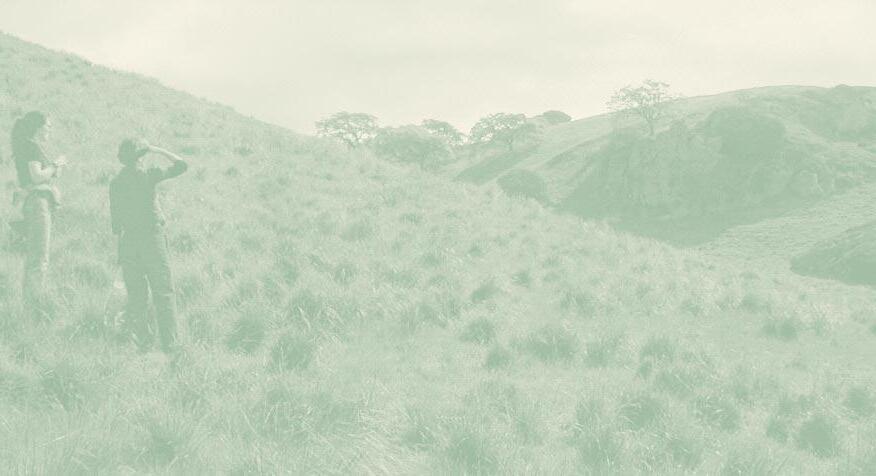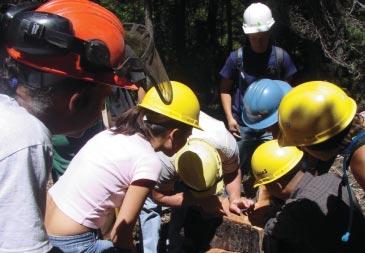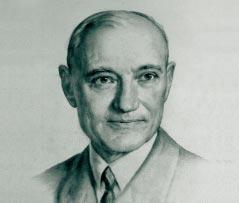
4 minute read
Highlights of Excellence
In 1974, the forestryprogram began a significant series of organizational changes. Under the leadership of John Zivnuska and E. Gorton Linsley, the School of Forestryand Conservation merged with the College of Agricultural Sciences to form the College of Natural Resources. In 1992, the Department of Forestrybecame a division of the Department of Environmental Science, Policy, and Management. And in 2003, the forestry facultytook up residence throughout the College rather than within one department or division.
ìForestryhas become so diverse that it can no longer be contained in one department,îsaid Rick Standiford, Associate Dean for Forestryand Capital Projects. Standiford lists Associate Professor Allen Goldsteinóa biogeochemist in the College studying human-induced atmospheric changesóas a prime example of this interdisciplinarynature. ìSomeone like Allen would never have been considered a forestryresearcher 15 years ago. Nowheís running one of the keyprojects at Blodgett Forest.î
Advertisement
At a summit with industry, academics, and land managers held last fall to discuss the future of the forestryprogram, Mark Rey, undersecretaryof USDA Forest Service, said that 90 percent of the senior managers in the Forest Service and Natural Resources Conservation Service will be eligible to retire within the next five years. The College is well-positioned to provide the next generation of natural resource leaders.
Berkeley researchers conducted some of the first work on prescribed burning as a management tool.
As the population of California grows and the separation between urban and rural areas decreases, the forestryprogram at Berkeleyis more important than ever. The Collegeís forestryand fire experts routinelytestifyat Congressional hearings on issues such as wildfire management and protection of important natural areas such as the Lake Tahoe Basin. Max Moritz just joined the program as the nationís first Cooperative Extension specialist in fire management (see the Facultysection of this issue for more on Moritz).
And newtechnologies are allowing scientists to look at forest issues from myriad angles.
Says Standiford: ìTodaywe can look at the forest from molecular to global levelsóthrough a microscope, or from space. This allows us to understand forests in ways that were never before possible.î
The Facultyof Forestrycomprises more than 50 scientists and Extension academics throughout the College, in other areas of the Berkeleycampus, and in the UC Division of Agriculture and Natural Resources.

Interdisciplinary, Ecology-Based Rangeland Science
Arthur Sampson was an established plant ecologist when he joined the College of Agriculture in 1922. As a professor in the Division of Forestry, he launched the field of rangeland science with three important books between 1923 and 1928: Range and Pasture Management; Native American Forage Plants; and Livestock Husbandryon Range and Pasture.

Sampson was especiallyinterested in the ecologyof western ranges and began research that addressed issues still of importance today, such as managing undesirable plant species and the role of fire on rangeland ecology. He was one of the first researchers to studygrazing and watershed problems in the West, and the first to teach a continuing course in range management.
With the support of ForestryChair Walter Mulford, Sampson advocated an interdisciplinaryeducation for range scientists, supplementing range training with the physical, biological, and economic sciences. Ever since Sampsonís time, the rangeland science program at Berkeleyhas set itself apart as ecologicallybased and interdisciplinary.
Rangeland science continued to gain in stature as the California Forest and Range Experiment Station was located on the Berkeleycampus in 1925. In 1933, a Range Committee was established, at first to investigate the long-term effects of brush burning. Their results, which found no deleterious effects from systematic brush removal, eventuallyconvinced the legislature to remove some prohibitions against brushland burning.
Professor Emeritus Harold Heady, another keyfigure in the historyof rangeland science, joined the College facultyin 1951. Headywas the first to explain the dynamics of annual grasslands, with application to Mediterranean grasslands worldwide. He was awarded the Societyfor Range Managementís top honor in 1980 for sustained outstanding accomplishment in range management or science and received the Berkeley Citation in 1991.
Subsequent generations of students continued to make key discoveries about grasslands. Professor Jim Bartolome was the first to disprove a long-held theorythat purple needle grass dominated native perennial grasslands. He also discovered that annual grasslands can be managed productivelyfor biodiversityusing residual drymatter, a technique nowused routinely.
Others in the College challenged and refined models of ecosystem change in Mediterranean woodlands, analyzed grazing impacts on water quality, and documented landowner goals in the management of private rangelands.
Professor Barbara Allen-Diaz, originallya student in Bartolomeís laboratoryand nowExecutive Associate Dean of the College, illustrated that livestock could be used as a vegetation management tool in forests, as a chemical alternative. Livestock are nowroutinelyused to remove unwanted or invasive vegetation.
In 1986, the program was augmented bya newUC systemwide range program, the Integrated Hardwood Range Management Program. The IHRMP joins researchers across UC campuses to ensure sustainabilityof the stateís 10 million acres of hardwood rangelands.
Although CNRís range program has always maintained an ecological focus, computers led to changes in the wayresearch was conducted. ìThe cutting edge of range ecologyhas become more quantitative, with better theoretical models and an abilityto handle complex data sets,îsaid Bartolome. ìThere has also been a shift in the specific problems we work on. While previouslywe focused on livestock grazing, todaywe address more social issues.î
Associate Professor Lynn Huntsinger took an earlylead on social issues with research into rangeland landowner practices, goals, and values in California. This work helped launch the dramatic nationwide shift over the last 10 years in attention to private-lands conservation and landscape-level conservation programs, as well as the inclusion of human-values research and programs into rangeland management.
Allen-Diaz predicts that rangeland science of the future will still revolve around indicators for sustainability, involving the social and environmental effects of grazing animals. ìLivestock animals graze on more than half of the Earthís lands. Distribution and composition of grasslands and shrublands are keyto a wide varietyof issues, ranging from carbon storage and global climate conditions, to local economics and social structure of pastoral and nomadic societies.î
The programís interdisciplinarytradition will also continue. Said Bartolome, ìThe current organization of environmental science allows for a high level of collaboration byBerkeleyrange facultywith other environmental scientists. We have an 80-year historyof questioning traditional ideas in management and ecology.î



